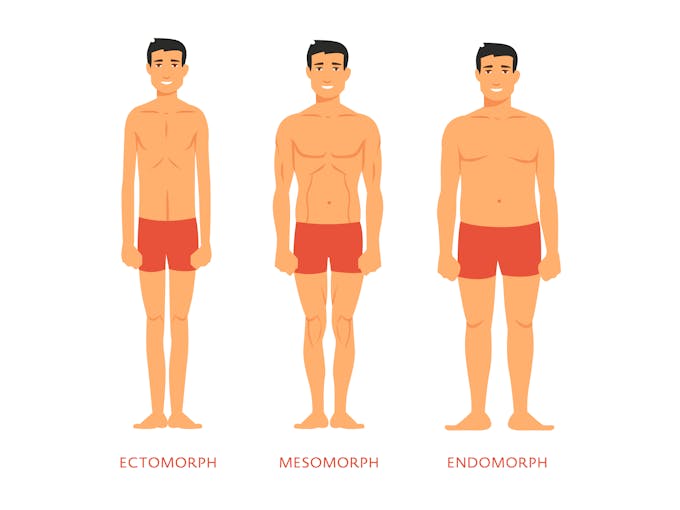Ectomorph Body Type Explained

How to Read Your Body
Learn to recognize common symptoms and uncover their underlying health issues
Understand the signs of nutrient deficiencies to manage your health
Explore the four metabolic body types and the core factors that influence them
Interpret your body's signals from head to toe to identify potential health concerns

How to Read Your Body
Learn to recognize common symptoms and uncover their underlying health issues
Understand the signs of nutrient deficiencies to manage your health
Explore the four metabolic body types and the core factors that influence them
Interpret your body's signals from head to toe to identify potential health concerns

How to Read Your Body
Learn to recognize common symptoms and uncover their underlying health issues
Understand the signs of nutrient deficiencies to manage your health
Explore the four metabolic body types and the core factors that influence them
Interpret your body's signals from head to toe to identify potential health concerns

How to Read Your Body
Learn to recognize common symptoms and uncover their underlying health issues
Understand the signs of nutrient deficiencies to manage your health
Explore the four metabolic body types and the core factors that influence them
Interpret your body's signals from head to toe to identify potential health concerns

How to Read Your Body
Learn to recognize common symptoms and uncover their underlying health issues
Understand the signs of nutrient deficiencies to manage your health
Explore the four metabolic body types and the core factors that influence them
Interpret your body's signals from head to toe to identify potential health concerns

How to Read Your Body
Learn to recognize common symptoms and uncover their underlying health issues
Understand the signs of nutrient deficiencies to manage your health
Explore the four metabolic body types and the core factors that influence them
Interpret your body's signals from head to toe to identify potential health concerns

How to Read Your Body
Learn to recognize common symptoms and uncover their underlying health issues
Understand the signs of nutrient deficiencies to manage your health
Explore the four metabolic body types and the core factors that influence them
Interpret your body's signals from head to toe to identify potential health concerns

How to Read Your Body
Learn to recognize common symptoms and uncover their underlying health issues
Understand the signs of nutrient deficiencies to manage your health
Explore the four metabolic body types and the core factors that influence them
Interpret your body's signals from head to toe to identify potential health concerns

How to Read Your Body
Learn to recognize common symptoms and uncover their underlying health issues
Understand the signs of nutrient deficiencies to manage your health
Explore the four metabolic body types and the core factors that influence them
Interpret your body's signals from head to toe to identify potential health concerns

How to Read Your Body
Learn to recognize common symptoms and uncover their underlying health issues
Understand the signs of nutrient deficiencies to manage your health
Explore the four metabolic body types and the core factors that influence them
Interpret your body's signals from head to toe to identify potential health concerns

How to Read Your Body
Learn to recognize common symptoms and uncover their underlying health issues
Understand the signs of nutrient deficiencies to manage your health
Explore the four metabolic body types and the core factors that influence them
Interpret your body's signals from head to toe to identify potential health concerns

How to Read Your Body
Learn to recognize common symptoms and uncover their underlying health issues
Understand the signs of nutrient deficiencies to manage your health
Explore the four metabolic body types and the core factors that influence them
Interpret your body's signals from head to toe to identify potential health concerns
Do you seem to have a fast metabolism and can’t gain weight no matter what you do? You most likely have an ectomorph body type.
Metabolic body types are genetically determined and explain how your metabolism impacts body shape and body composition. Understanding your metabolic body type helps you gain muscle and reach your fitness goals fast.

What are the three metabolic body types?
Metabolic body types are determined by the relationship between metabolism and the nervous system.
Your metabolism determines how quickly and efficiently your cells convert fuel to energy. The effectiveness of your metabolism is primarily impacted by your genetics. However, factors including quality of sleep, exercise routines, and dietary choices can influence how fast or slow your metabolism works.
Your autonomic nervous system controls physical functioning, including digestion, breathing, and heart rate, and is balanced by two opposing sides.
The sympathetic nervous system is activated during stress. It requires more calories, resulting in a higher need for energy and less body fat.
The muscle-relaxing and calming parasympathetic nervous system requires less energy and preserves the body's fuel sources, typically resulting in more body fat.
While both nervous systems regulate body functioning, most people tend to have one dominant nervous system trait that determines the body's overall energy needs.
It's the interplay between your dominant nervous system trait and the effectiveness of your metabolism that determines your body composition and metabolic body type.
Research suggests that the three main metabolic body type classifications are ectomorph, mesomorph, and endomorph.
Ectomorph
The ectomorph body type has a small body frame with narrow hips and shoulders. Ectomorphs have a fast metabolism and burn calories quickly, explaining why this body type loses weight easily.
Mesomorph
The mesomorph body type has a medium frame with a rectangular bone structure and broad shoulders. Mesomorphs have an effective metabolism and moderate amounts of body fat. They tend to have a naturally athletic physique and lose fat easily.
Endomorph
Endomorphs have a larger round body than the other types and are prone to excess body fat. This body type typically has weaker upper body muscles and a slow metabolism. Endomorphs typically gain fat quickly and find it hard to lose weight.
Understanding your body type helps you achieve a healthy weight and supports your well-being.

Ectomorph body type explained
The ectomorph body type is slim and tall, with a narrow waist and a slender upper body. Ectomorphs typically have a small chest, thinner bones, and less body fat than other metabolic body types.
Ectomorphs are lean but have a lower muscle mass percentage than mesomorphs, making it challenging to gain muscle definition.
People with an ectomorph body type tend to have a fast metabolism. A high energy turnover combined with low body fat makes it hard for ectomorphs to gain weight—no matter what they eat.
Ectomorph body type characteristics:
Small frame and shoulders
Lean body with long limbs
Flat chest
Often taller than average
Fast metabolism
Lose weight easily

What diet and exercise benefit ectomorphs?
Ectomorphs' fast metabolism burns calories quickly, and this body type benefits from a nutrient-dense, high-quality diet like Healthy Keto®.
Keto's high-fat and medium-protein ratio is ideal for the ectomorph metabolic body type. It provides plenty of energy-dense and nutrient-rich foods for optimal nutrition and sustainable energy.
You may have heard that carbohydrates are a great energy source for the ectomorph body type. This isn’t necessarily true. Research suggests that a diet high in carbs can result in a skinny-fat body.
Consumption of carbohydrates will release insulin in response to increased blood sugar. Insulin's main role is to regulate blood sugar, but it also shifts your metabolism to store fat.
A diet high in carbohydrates and whole grains leads to a soft-ectomorph body characterized by a narrow body frame with excessive belly fat. Ectomorphs typically thrive on a nutrient-dense diet rich in healthy fats for sustainable energy.
Ectomorphs can find it challenging to build muscle. An exercise routine combining resistance training, weight training, and high-intensity interval training (HIIT) is ideal for this body type and helps with gaining muscle mass.
Incorporate cardio workouts only occasionally to avoid weight loss and preserve lean muscle.

Metabolic vs. hormonal body types
Metabolic body types are a structural classification of body composition that indicates how effectively your metabolism converts food to energy.
Your genes largely determine your metabolic body type, but factors including diet, lifestyle choices, and exercise habits also influence your body type.
Hormonal body types explain how hormone levels affect your body’s fat distribution. Hormones significantly determine your overall body composition and affect how your body metabolizes energy and stores fat.
Imbalanced hormone levels are often the root of persistent weight and the inability to gain muscle mass. Understanding how hormones influence your fat distribution helps you formulate a diet that benefits your health and supports your weight goals.
Here are five hormonal body types.

Adrenal body type
The adrenal body type generally is characterized by a sagging belly caused by elevated levels of the stress hormone cortisol produced in your adrenal glands. The adrenal body type benefits from stress reduction, a nutritious diet, and plenty of sleep.
Thyroid body type
Thyroid body types typically experience weight gain all over the body. Imbalances of thyroid hormones slow the metabolism and cause weight gain.
Liver body type
The liver body type is characterized by a protruding pot belly. Impaired liver function leads to low levels of human growth hormone, which is necessary for fat-burning. Avoiding alcohol and excessive amounts of protein is essential for this hormonal body type.
Ovary body type
Ovary body types carry excess fat around the hips and thighs and are most commonly caused by estrogen imbalance.
Pancreas body type
The pancreas body type is the most common hormonal body type and is similar to the adrenal body type with a sagging belly. The pancreas body type is likely insulin resistant as a result of chronic blood sugar imbalances and benefits from a low-carb, high-fat diet like keto.

Key takeaways
The ectomorph body type has a slender body shape and low body fat, indicative of a fast metabolism. This body type often finds it hard to achieve muscle gain and benefits from resistance training and strength workouts.
Ectomorphs thrive on a nutrient-dense, high-quality diet like Healthy Keto that provides sustainable energy and supports muscle growth.
FAQ
1. What are the three metabolic body types?
The three main metabolic body types are ectomorph, mesomorph, and endomorph.
2. How do I know if I’m the ectomorph body type?
If you describe your body shape as long and slender, find it hard to gain weight, and have narrower hips than most people, you’re likely an ectomorph body type.
3. What’s the difference between metabolic and hormonal body types?
Metabolic body types classify body shapes and body compositions. They are based on the relationship between metabolism, genetics, and the nervous system.
Hormonal body types explain how hormonal imbalances influence body fat distribution.
Addressing underlying health issues and balancing hormones helps hormonal body types to achieve their weight goals and support a healthy body.
Take this body type quiz to figure out your hormonal body type.
4. What is the ectomorph body type?
The ectomorph body type is characterized by a slender, narrow body frame with narrow hips and shoulders. This body type generally is tall with long limbs and a flat chest.
Ectomorphs tend to have a fast metabolism and low body weight. They lose weight easily and have less muscle mass than other body types, making it hard for ectomorphs to achieve muscle gain and definition.
5. What is the mesomorph body type?
Mesomorphs typically have a medium-sized frame with a rectangular bone structure and broad shoulders. The mesomorph body type has well-developed legs and arms, moderate amounts of body fat, and more muscle compared to other metabolic body types.
The mesomorph body type indicates an effective metabolism. People with this body type often have a naturally athletic appearance and quickly lose fat.
6. What is the endomorph body type?
The endomorph body type has a larger body frame, a rounder bone structure, and weaker upper body muscles than other body types.
Endomorphs have a slow metabolism and are prone to excess body fat. They often find it challenging to lose weight and gain fat easily.
7. Are metabolic body types the same as hormonal body types?
No, metabolic body types aren’t the same as hormonal body types.
Most people can be classified into one of the metabolic body types, but not everyone develops a hormonal body type caused by underlying hormone imbalances.
Hormonal imbalances can result from poor eating habits, stress, impaired liver function, and inadequate sleep.
Previous blog
Metabolic Body Types ExplainedNext blog
Endomorph Body Type ExplainedTags

Popular
08/21/2024
46.4K views
05/22/2024
40.8K views
11/18/2024
242K views
03/18/2024
11/21/2022




